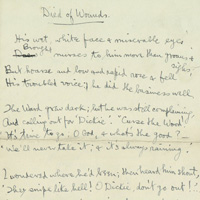The Siegfried Sassoon Collection
'I am a soldier, convinced that I am acting on behalf of soldiers. I believe that this War, on which I entered as a war of defence and liberation, has now become a war of aggression and conquest.'
Declaration against the War

Biography
Siegfried Loraine Sassoon (1886–1967)
Siegfried Sassoon was born at Weirleigh outside of the village of Matfield in Kent on 8th September 1886 to Alfred Ezra Sassoon, a member of a wealthy Jewish merchant family, and to Georgiana Theresa Thornycroft, who came from a family of prominent sculptors. Theresa was an Anglo-Catholic, and her marriage to Alfred resulted in his being disinherited by the Sassoons. Siegfried had one older brother, Michael, born in October 1884, and one younger brother, Hamo, born in 1887. His parents separated when he was very young, meaning that in his younger years he saw his father only rarely. Alfred died of consumption in 1895.

As a child Siegfried was prone to illness, and spent many hours reading and writing poetry. Despite his mother’s reservations, he was finally sent to study at the New Beacon School in Kent in 1900, followed by Marlborough College in 1902. In 1905 he went up to Clare College, Cambridge, where he officially read law at the encouragement of his uncle, Sir Hamo Thornycroft, but in practice spent the majority of his time hunting, golfing and reading and writing poetry. His senior tutor, W. L. Mollison, urged him to publish his poetry, which he did in a private volume in September 1906. He subsequently left Cambridge after only a year without a degree and lived the life of a country gentleman publishing nine pamphlets between 1906 and 1912 encouraged by luminaries such as Edmund Gosse, Edward Marsh, and Robert Ross.
Siegfried joined the Sussex Yeomanry on 4th August 1914, the day that England declared war, but soon after broke his arm in a hunting accident. He received his commission as a second lieutenant in the 3rd Battalion, Royal Welch Fusiliers in May 1915. While drilling at Litherland in November 1915, he received word of Hamo’s death at Gallipoli.
Siegfried left England to join his battalion in France on 17th November just after the Battle of Loos, serving as a transport officer. In March 1916 Siegfried was finally able to secure a front-line placement. He displayed courage and calm under fire, receiving a Military Cross for his actions during a raiding party in May 1916; in fact he displayed such bravery that he attracted the nickname 'Mad Jack'. He spent the early summer of 1916 on leave, returning to his battalion for the Somme offensive in July. He contracted dysentery, and was invalided to Somerville College, Oxford.
During his recovery period, discouraged by the politics of war at home and the deaths of numerous friends at the front, he made contact with the group of pacifists led by Bertrand Russell and Lady Ottoline Morrell. He returned to France in January 1917, was wounded by a sniper during a raid near Fontaine-les-Croisilles in April, and was sent back to England. Encouraged by Russell and the journalists John Middleton Murry and H. W. Massingham, he wrote his soldier's statement (or 'declaration against the War'), dated 15th June 1917, calling for a negotiated peace, and acted to resign his commission. Robert Graves intervened, fearing that his friend would be court-martialled. His commanding officers were sympathetic, and sent Siegfried to Craiglockhart War Hospital near Edinburgh to be treated for neurasthenia. There he met and formed a friendship with the psychiatrist W. H. R. Rivers, and the poet Wilfred Owen and worked on the hospital's literary journal, The Hydra.
In February 1918 Siegfried was dispatched to serve in Palestine, but in May found himself back in France with the battalion supporting allied forces shaken by the St Michael’s Offensive of March. On 13th June while returning to the trenches from a patrol in No Man's Land he was accidentally mistaken for a German by a sentry from his company, and was shot in the head. This event ended his direct experience of the war.
Throughout his war service he continued to read and write poetry, encouraged by Robert Graves. He published a series of volumes containing poems inspired by the war: The Old Huntsman (1917); Counter-Attack and Other Poems (1918); and Picture-Show (1919).
In the inter-war years he developed a wide literary circle, lived in Oxford and involved himself in Labour politics, served as literary editor for the Daily Herald, and travelled widely in the United States and Europe. He published his semi-autobiographical trilogy, including Memoirs of a Fox-Hunting Man (1928); Memoirs of an Infantry Officer (1930); and Sherston’s Progress (1936). He later added a series of more factual autobiographies to these culminating in Siegfried’s Journey (1945). He became friends with fellow war-poet Edmund Blunden, but fell out with Robert Graves. Following a series of failed homosexual affairs, in December 1933 Siegfried married Hester Gatty and purchased Heytesbury, an estate in Wiltshire. Their son George, whom Siegfried adored, was born in 1936. The couple separated a few years later. In 1951 Siegfried was made a Commander of the Order of the British Empire, in 1953 became an honorary fellow at Clare College, Cambridge, and in 1965 received an honorary degree from Oxford University. He died at the age of 80 and is buried at St Andrew’s Church, Mells, Somerset. On 11 November 1985 his name, along with 15 others, was added to a slab in Poets' Corner in Westminster Abbey.
| Author | Alisa Miller and Stuart Lee |
|---|---|
| Sources |
|
Search the Siegfried Sassoon Collection
Find a specific poem
Find other items
- Photographs of Siegfried Sassoon
- Archival Holdings:


